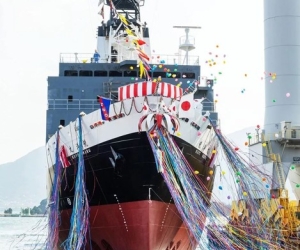
In 2021, an overwhelming 82 percent of methane emissions from international shipping could be traced back to liquefied gas tankers, primarily LNG carriers, according to the International Council on Clean Transportation (ICCT).
The data is derived froman analysis conducted using the ICCT’s Systematic Assessment of Vessel Emissions (SAVE) model, Hae Jeong Cho, ICCT Associate Researcher said.
Gas tankers are followed by offshore vessels, RoPax ferries, cruise ships, and container ships.
The analysis further highlighted the concentration of methane emissions along LNG trade routes, emphasizing potential areas for targeted regulatory measures.
Diving into the engine types, the report indicated that a staggering 98% of methane emissions in 2021 originated from low-pressure engines, known for their higher methane slip compared to high-pressure alternatives. Within this category, low-pressure, dual-fuel, four-stroke (LPDF 4-stroke) engines claimed the majority (86%) of emissions. These engines, commonly favored by LNG carriers, were noted for their estimated higher methane slip.
Another 12% of methane emissions were from LPDF 2-stroke engines, which have lower, but still substantial, methane slip. Methane emissions from other engine technologies—high-pressure, dual-fuel two-stroke (HPDF 2-stroke), lean-burn spark ignition (LBSI), steam turbines (ST), and gas turbines (GT)—were relatively insignificant.
Installations of high-methane-slip LPDF 4-stroke engines are on the rise. More than half of cruise ship capacity by gross tonnage to be built between 2023 and 2025 will run on LNG using these engines, according to IHS Markit (nka S&P Global) data as of July 2023. The relative share of LPDF 4-stroke engines among engine types in LNG-fueled ships is declining amid growing use of medium-methane-slip LPDF 2-stroke engines that are increasingly used in gas tankers and the low-methane-slip HPDF 2-stroke engines found in most new LNG-fueled container ships and vehicle carriers, Cho noted.
Methane is the principal component of natural gas, and when natural gas is cooled to extremely low temperatures, it becomes a liquid, resulting in LNG. Therefore, LNG is essentially methane in a liquefied form.
When LNG is burned as a fuel, it releases energy and produces carbon dioxide (CO2) and water vapor, along with smaller amounts of other pollutants. While CO2 is a significant GHG, burning methane releases less CO2 compared to other fossil fuels, making LNG a relatively cleaner-burning fuel.
However, a key environmental concern related to LNG is “methane slip”, the unintentional release of unburned methane during the combustion process. Methane is a potent greenhouse gas, with a higher warming potential than CO2 over a shorter timeframe. Any methane slip can contribute to GHG emissions and impact the overall environmental footprint of LNG.
The assessment of the environmental impact of LNG includes considering the entire life cycle, from production and transportation to combustion. Methane leakage during the extraction, processing, and transportation of natural gas contributes to the life-cycle GHG emissions associated with LNG.
Bearing all this in mind, the figures on methane emissions are derived from limited data and several initiatives are underway to accurately measure methane slips from ships.
While LNG currently accounts for a lion’s share of newbuilds on order, some alternatives like methanol are stepping in as the next best thing.
Nevertheless, ICCT believes the time has come for the IMO to clamp down and regulate the life-cycle GHG intensity of marine fuels similar to the FuelEU maritime regulation, which will require ships to reduce the life-cycle GHG intensity of onboard energy use as of 2025.
“The earliest the GHG Fuel Standard (GFS) could enter into force is 2027, and if it is to spur emissions reductions that would achieve IMO’s 2050 goal, the GFS will have to break from historical patterns of lagging behind the European Union and be more stringent from the start. After all, the EU regulation aims for 80% reduction in the GHG intensity, not 100%, by 2050. In the meantime, regions or countries could set more ambitious regulations that target methane pollution in their waters. For the more than 150 countries that have signed on to the Global Methane Pledge, reducing methane emissions from ships that call on their ports or sail in their waters would help to achieve the goal of reducing global methane emissions by 30% between 2020 and 2030,” Cho pointed out.
“And to be clear, alternatives to LNG are out there. Methanol avoids the methane slip problem and is liquid at room temperature. Other options expected to be available in the longer term include hydrogen fuel cells or batteries. For LNG carriers that continue to use LNG as their fuel, low-methane-slip HPDF engines are a better choice for the environment than the LPDF engines that have long dominated the class. Regulations like a strict GFS that could support the adoption of fuels with lower life-cycle GHG emissions.”













